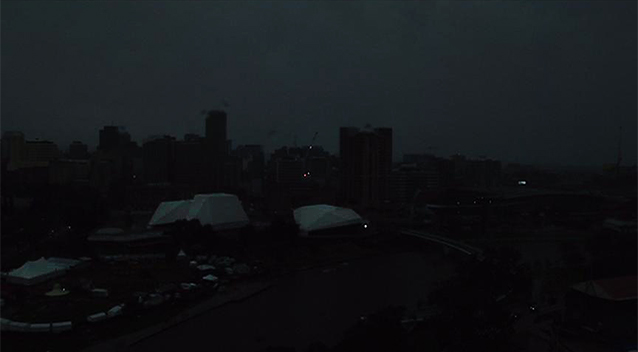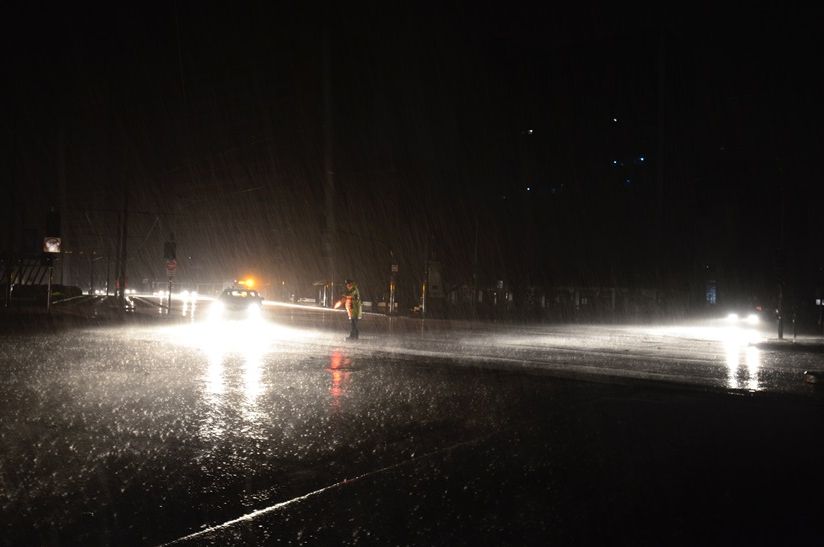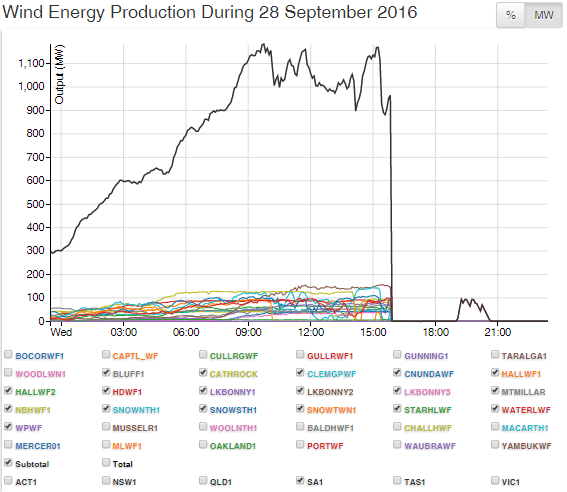On 28 September 2016, the automatic shutdown of wind turbines in South Australia during a spring storm delivered a statewide ‘system black’.
South Australia’s hapless Premier, Jay Weatherill led the wind industry’s propaganda charge, pointing the finger at the collapse of a couple of power pylons in the state’s mid-North as the cause of a statewide calamity that left 1.6 million people powerless; and parts of the State without electricity for more than a week. BHP Billiton’s Olympic Dam mine in South Australia’s far north was without full power from September 28 to October 13.
The collapse of a few power pylons occurred late in the day, and affected a single transmission line that could not have caused the collapse of the State’s entire power supply. The rest of the State’s transmission lines remained untroubled by the strong winds. But the power pylons collapse is still touted by renewables advocates as the primary cause.
The Australian Energy Regulator took a different view and started pursuing South Australia’s wind power generators for their part in the disaster. The AER commenced legal proceedings against four wind farm operators, including Tilt Renewables, Neoen, Pacific Hydro and AGL Energy.
Finally, four years later, the AER managed to extract a paltry million dollars out of one of the offenders: Tilt Renewables, formerly known as Trustpower. Paltry that is, bearing in mind that the blackout cost South Australians hundreds of millions of dollars.
Wind farm operator fined $1 million for breaching national energy rules before SA statewide blackout
ABC News
Meagan Dillon
22 December 2020
A South Australian wind farm operator has been fined $1 million for contravening national electricity rules in the three years leading up to the 2016 statewide blackout.
The company was accused of supplying electricity to the grid despite not having protection system settings approved by the Australian Energy Market Operator (AEMO).
According to the judgement, SWF2 was a wholly owned subsidiary of Trustpower Limited, a publicly listed New Zealand power company, at the relevant time.
The AER also launched legal action against three other wind farms — Hornsdale, Pacific Hydro’s Clement’s Gap and AGL’s Hallett farms — but the outcomes of those cases have yet to be determined.
The blackout occurred on September 28, 2016, when extreme weather, described at the time as “twin tornadoes”, caused major damage to electricity infrastructure, knocking down huge transmission lines.
The AER said a subsequent loss of wind generation then triggered the blackout, which left 850,000 customers without power.
SWF2 accepted the $1 million penalty for failing to adequately protect its wind farm from “abnormal voltage”.
Justice Richard White said the contravention was “not deliberate” and the company “took prompt steps to rectify the situation”.
The Federal Court today ordered the company — which has 90 wind turbines in SA’s mid north — to implement a compliance program and hire an independent “compliance expert” to ensure it abides by the rules in the future.
The expert will then provide a written compliance report to the court after six months.
Justice White said the wind farm had low-voltage protection systems fitted to each of its turbines to protect “against abnormal voltage excursion of the power system” — but they were set at a lower threshold than required by the National Electricity Rules (NER).
“The ability of wind farm turbines to continue operating (‘to ride through’) periods of voltage fluctuations … is an important requirement for their connection to the power system in the NEM (National Electricity Market),” he wrote in his judgement.
“That feature reduces the ability of voltage disturbances arising from faults and other occurrences to cause cascading failures in the system and thereby enhances the ability of AEMO to maintain ‘power system security’ and, in particular, to avoid blackouts.”
A lone policeman directs traffic near Victoria Square in Adelaide’s CBD during the statewide blackout in September 2016.
He said the NER “imposes an obligation” on generators of electricity, such as SWF2, to have protective systems in place to deal with episodes of abnormal voltage in the power system.
“The purpose of such systems is to ensure that the generating units remain in continuous operation during specified disturbances and thereby to assist AEMO in maintaining power system security,” he said.
“On 28 September 2016, six under-voltage disturbances occurred on the power system within a period of approximately 90 seconds.
“In response to the sixth under-voltage disturbance, the [low-voltage protection system] was activated on 34 of the 37 turbines then in service, with the consequence that they shut down and ceased to supply active power to the power system.
“This was associated with the widespread electricity blackout which occurred in South Australia on that day.”
Justice White ordered SWF2 to pay the “Commonwealth of Australia a pecuniary penalty of $1 million in respect of the contravention”.
He also ordered SWF2 to pay the AER’s court costs of $100,000.
ABC
Wind farm slugged $1m over blackout issues
The Standard
Tim Dornin
22 December 2020
The operators of a South Australian wind farm have been slugged $1 million for failing to properly comply with mandated performance standards in the lead-up to the statewide blackout in September 2016.
In a judgment on Tuesday, the Federal Court also ordered the operators of the Snowtown Wind Farm Stage 2 in the state’s mid-north to engage a compliance expert to review its operations and provide a report on any gaps.
Justice Richard White found the wind farm had contravened the national electricity rules by operating for about three years with inadequate protection settings to cope with or “ride through” disruptions to the power network.
Those settings had not been approved by the Australian Energy Market Operator and were set to a lower threshold than was advised, meaning they would trip sooner in the event of a fluctuation.
Justice White said the wind farm’s contravention of the rules was serious and its use of non-approved settings compromised AEMO’s ability to provide secure power services.
“As the events of 28 September 2016 indicate, a compromise of the security of the power system can have extensive and serious consequences,” he said.
In the immediate lead-up to the statewide blackout, severe storms damaged more than 20 towers in SA’s mid-north, bringing down major transmission lines and causing a knock-on effect across the state’s energy grid.
About 850,000 customers lost power, with some in the state’s north and on the Eyre Peninsula left without electricity for several days.
A report from AEMO released about a month later found nine of 13 wind farms online at the time of the blackout switched off when the transmission lines came down.
It found the inability of the wind farms to ride through those disturbances was the result of safety settings that forced them to disconnect or reduce output.
The $1 million fine and the compliance review ordered by Justice White were in line with an agreed position between the parties, including the Australian Energy Regulator which had instigated the court action.
The AER has also launched proceedings against other wind farm operators in SA.
Tilt Renewables, which operated the Snowtown facility at the time of the blackout, said it was pleased with the outcome of proceedings.
The company, which sold the wind farm in December last year, said the fine would not impact on its earnings this year with the anticipated penalty included in the profit from the sale.
AER chair Clare Savage said the regulator took conduct that affected system security extremely seriously.
“As wind farms make up an increasing proportion of our generation mix, it is more important than ever that they comply with the National Electricity Rules,” she said.
“This penalty outcome sends a strong message to all generators that the AER will take court action when necessary to enforce the National Electricity Rules.”
The Standard
Both the ABC and The Standard run the hackneyed line about pylons collapsing on a single transmission line during a storm causing all the trouble. Had they bothered to look a little closer, they might have identified the fact that the pylons and transmission line did not fail until late in the day (see above) and that the issues relating to transmission lines occurred after 4.16pm that day.
The real issue is that South Australia’s fleet of whirling wonders were never designed to perform in a storm, which they clearly didn’t that day. Here’s STT’s report posted the day after the disaster struck: Another Statewide Blackout: South Australia’s Wind Power Disaster Continues
The target of the AER’s action against Tilt Renewables was what occurred at its Snowtown windfarm. Evidenced by events that occurred much earlier in the day; and well before any pylons collapsed or transmission lines faulted.
It is now a given that the forced shut down of 315MW of wind power output caused the complete collapse of SA’s grid, and it is unarguable that wind turbines were shut down as wind speeds increased on Wednesday, 28 September.
In a cascade of events, the progressive and rapid shutdown of turbines – due to high wind speeds – caused a drop in voltage across that part of the grid dominated by wind turbines in SA’s mid-North, and the resulting drop in voltage triggered the turbines’ on board control systems to shut down to prevent a loss of control.
As to the automatic shut down of turbines due to high wind speeds, take Tilt Renewable’s Snowtown 1, for example; which we have isolated in the graph above – care of Aneroid Energy.
The reason why 315MW of wind power output went missing, as STT followers are well aware, is that wind turbines automatically shut down when wind speeds exceed 25m/s (90km/h, 55mp/h or 48 knots), which it most certainly did on Wednesday, 28 September 2016.
At 9:00 am, Snowtown 1 is merrily producing close to 100% of its installed capacity of 99 MW. On 28 September one thing that South Australia wasn’t short of was wind, which reached gale force across the State, without relent: the hills at Snowtown were being buffeted by wind clocking over 100km/h throughout the day.
Notwithstanding an abundance of wonderful ‘free’ wind energy it was a complete ‘down tools’ at Snowtown 1 at 10:30am – with no return to work until 3:00pm; and then only for a 40MW spurt lasting a few minutes. That minor spurt occurred about 35 minutes before the entire grid went down. At 6:30pm there was another burst of activity, until just before 9:00pm; but, apparently the wind got the better of them, and Snowtown 1 was out for the rest of the day.
Wind turbines do not supply themselves with power to operate their internal control systems – that comes from the grid; and when the grid collapsed there was no power to control turbines, such that they could not be restarted even if the operators wanted to.
In the aftermath, STT predicted that there would be litigation pursued against the wind power outfits responsible. The immediate cost to South Australian households and businesses was in the order of $370,000,000: South Australia’s September Wind Power Blackout Cost Businesses & Households $367 Million
Finally, the Australian Energy Regulator has caught up with one of the culprits, from the same class of clowns who told us it had nothing to do with wind power, at all.
Welcome to your wind powered future!






How can not complying with regulations not be deliberate?
“Justice Richard White said the contravention was “not deliberate” and the company “took prompt steps to rectify the situation”.” Talk about a ‘gimme’.
What would Justice White’s findings be of RE providing ‘secure power services’? I hate to think.
It’s known wind turbines kill people as well, under increasing implementation of ‘workplace manslaughter laws’ where do these life slashers and burners fit? And oddly, the RSPCA and other organisations are very quiet on the killing fields, even on Tasmanian eagles. Why? Complicity?
As large transmission lines are fault checked by helicopter every week, including for bird’s nests, I guess that problem is decreasing.
Engineering well knows the more complex the system the more things are likely to go wrong. Aviation and military systems, including computerisation, are built to a higher standard than other commercial and retail products. RE’s myriad repetitious complexity are all accidents waiting to happen. Apparently unacknowledged is that ‘accidents’ keep happening, yet anti nuclear deniers still living in the 60s, cite three examples that could have been prevented; 3 Mile Island’s cause was a contractor blanking off a cooling pipe, Chernobyl was built on the cheap, and Fukushima could have been prevented had Japan listened to an Italian scientist’s warning. Only one was responsible for human deaths. How many people have been killed by wind turbines so far?
The inevitable reply from the RE luvvies whenever a coal powered station goes down is ,(which is a very rare occurrence) …”coal is unreliable!”
They conveniently forget that renewables stop and start 24 hours per day, every day, 365 days per year. Then they have the hide to refer to renewables as the way of the future! Sod off!
Welcome back STT and what a good article to begin the year with.
It’s interesting to read the reports by different publications, the Adelaide Advertiser (23.12.20) reported that Trustpower who supplied to turbines built by Siemens was not aware until this Blackout that their settings had not been approved by AEMO or that the system had not been assessed during the 3 years of operation.
What does this say about how these companies are being controlled, or what the process or lack of it is to ensure they are erected and operated to regulations.
What does it say about what other regulations they are ignoring, operations which could be causing problems such as insufficient noise limitation!
Who is actually in control – the Government, the regulators or the companies – I think we all know who, and this case exposes the manner in which these companies believe they can do what ever they like without anyone getting out there and ensuring they are operating within the boundaries of their approvals.
It also indicates they are being ‘protected’ by Governments who are ashamed – or should be, of how they have let the people down by not ensuring what they allow to be erected in their States are suitably safe and fit for purpose and do not have the propensity to cause harm – financial or physical to their citizens.
The way the SA Government came out ‘screaming’ the blackout was the fault of the weather not the turbines is ludicrous and a direct desire to protect the industry from blame. Of course the weather had something to do with it but these things are or were meant to be ready to prevent such devastating events such as a State wide blackout.
If it had been a gas or coal power plant they would have been lambasted by the Government of the day as well as regulators immediately – what makes these Turbine company spinners so special that they have been able to getaway with not meeting regulations and being protected by all and sundry especially Politicians who are meant to work for the people not a reckless industry such as this.
Will it be a wake-up call, I doubt it, though if the other company’s being investigated are also found to be at fault maybe more people will begin to understand how ‘independently’ of regulations this industry has been and if that ‘independence’ has disadvantaged the people of this nation.
That, of course will no doubt depend on the profile this outcome and any further ones on the subject is dealt with by the major media outlets. To-date nothing much seems to have been printed or reported on it nationally, but then having the result of the Snowtown case reported just prior to Christmas Eve, along with all the other news items at the time didn’t help.
As the saying goes, if you keep fiddling with it, it`ll drop off! The ‘ruinable’ energy industry appears determined to sabotage the eastern grid, and then pass the blame onto the federal government when it all goes tits up!
Welcome back STT.